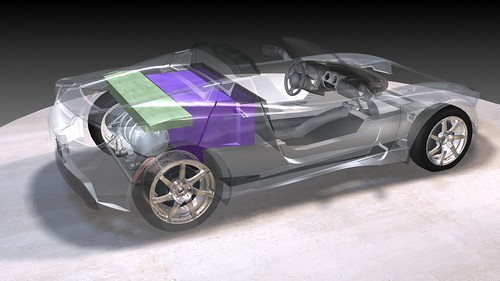The second generation of Tesla Roadster will look exactly the same, but sport a new “Powertrain 1.5”. This powertrain is an improved motor, inverter and gearbox designed to replace their previous two-speed transmission that had many durability, efficiency and cost challenges. The faulty 2-speed transmission effectively forced Tesla to sell its Roadster locked into second gear, dramatically hampering acceleration. The one speed transmission “improves motor torque by a bit more than 30% beyond what was already great and the ¼ mile time for the car is now in the 12.9 second range. The top speed of the vehicle remains over 120 mph,” according to Tesla CTO JB Straubel.
According to Tesla’s site, Powertrain 1.5 makes the following improvements:
- An improved inverter (PEM) to deliver higher motor current
- An improved motor to handle higher current and torque
- A new single-speed gearbox
- A new motor to gearbox coupler and an improved motor cable
- Upgraded vehicle firmware
- NO changes to the battery pack

PEM-green, Battery-blue, Electric Motor-under the PEM
The Power Electronics Module (PEM) basically acts as an amplifier and guide that converts and regulates the power from the battery to the motor. When you put the pedal to the floor you tell the PEM to give the motor some juice. By using newer IGBTs (Insulated Gate Bipolar Transistors) that convert and regulate power from the battery, they have been able to boost the PEM output current by about 33% from 640A rms to 850A rms with the same number of IGBTs. Fancy talk for using recent advances in electronic technology to make a more efficient PEM and a more powerful Roadster.
The motor has been improved by changing the casting in order to link with the new transmission. The motor terminal lugs have been changed, as well as the cable from the motor to the PEM to improve efficiency and reduce temperature rise.
The heart of the Powertrain 1.5 improvement is in the gearbox. CTO JB Straubel explains it best in his blog:
The new gearbox is the most significant change from powertrain 1.0 to 1.5. We have significantly reduced the complexity of this gearbox by getting rid of the need for shifting or speed matching between two gear sets. There is only one set of gears that is always engaged with a ratio of (8.2752:1). There are no clutches and we have also done away with the need for an electric oil pump and instead integrated a very efficient gear-driven oil pump into the gearbox. All of these simplifications have saved a great deal of mass and the new gearbox is approximately 45kg instead of 53kg for the old two-speed design.
This mass savings is even more impressive when you consider that we have designed this transmission to have a long life at a much higher input torque (400 Nm) and higher speed (14,000 rpm).
The engineering design of this new gearbox has been finished for over a month and we are now running prototypes through their paces on dynamometers. We built two initial gearboxes with machined aluminum housings so we could gain some early test results before finalizing the cast housing tooling and machining fixtures.
One of the most exciting features of this new gearbox (from an EV perspective) that we have been able to validate on the first prototypes is that it has extremely low spinning drag (less than 0.1 Nm of dry drag torque.) This is less than any other gearbox we have tested with the only possible exception being the EV1 gearbox. This low drag contributes to the 1.5 powertrain having a slightly improved range figure.
The two pictures below show some of the gears and shafts. On the left is the input shaft assembly…spinning up to 14,000 rpm bearing selection is very important. The spline on the right connects to the motor coupling. The picture on the right is the intermediate shaft assembly. Notice the transmission locking “gear” in the center that engages with a stationary pawl when the car is parked.
All these changes will dramatically improve performance without effecting the range or power draw from the battery. Tesla has learned a lot from its inaugural launch, hopefully with this more efficient powertrain they will ramp up production.
Sources: [MotorAuthority, Tesla Motors]





